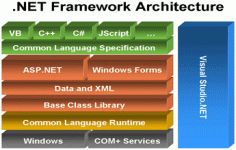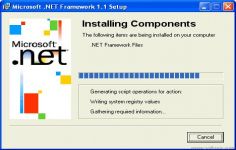 .NET Framework Version 3.5 SP1
.NET Framework Version 3.5 SP1
Microsoft Corporation - (Freeware)
.NET Framework is important for running applications developed under .Net platform.
Essential for the functioning of many software .NET Framework allows to run applications developed with the Microsoft.NET platform. In practice, the framework is used by many software.
.NET Framework offers among others a better support for multicore processors and increased performance, optimizing data access, support for SDK 2.0 Surface, Multi-touch Windows 7 menus tape and other additional features associated with the taskbar.
.NET Framework provides increased scalability and applications through improved caching, deploying and updating applications via ClickOnce, support the largest number of browsers and devices performance possible via the ASP.NET controls and services.
- Title:
- .NET Framework Version 3.5 SP1
- File Size:
- 2.8 MB
- Requirements:
- Windows XP / Vista / Windows7 / Windows8
- Language:
- en-us
- License:
- Freeware
- Date Added:
- 12 Aug 2008
- Publisher:
- Microsoft Corporation
- Homepage:
- http://www.microsoft.com
- MD5 Checksum:
- C626670633DDCC2A66B0D935195CF2A1
.NET Framework version 3.5 Service Pack 1 provides the following new features and improvements:
* ASP.NET Dynamic Data, which provides a rich scaffolding framework that enables rapid data driven development without writing code, and a new addition to ASP.NET AJAX that provides support for managing browser history (back button support). For more information, see Whats New in ASP.NET and Web Development.
* Core improvements to the CLR (common language runtime) that include better layout of .NET Framework native images, opting out of strong-name verification for fully trusted assemblies, improved application startup performance, better generated code that improves end-to-end application execution time, and opting managed code to run in ASLR (Address Space Layout Randomization) mode if supported by the operating system. Additionally, managed applications that are opened from network shares have the same behavior as native applications by running with full trust.
* Performance improvements to WPF (Windows Presentation Foundation), including a faster startup time and improved performance for Bitmap effects. Additional functionality for WPF includes better support for line of business applications, native splash screen support, DirectX pixel shader support, and the new WebBrowser control.
* ClickOnce application publishers can decide to opt out of signing and hashing as appropriate for their scenarios, developers can programmatically install ClickOnce applications that display a customized branding, and ClickOnce error dialog boxes support links to application-specific support sites on the Web.
* The Entity Framework is an evolution of the existing suite of ADO.NET data access technologies. The Entity Framework enables developers to program against relational databases in according to application-specific domain models instead of the underlying database models. For more information, see Getting Started with the Entity Framework. The Entity Framework introduces some additional features, including support for new SQL Server 2008 types, default graph serialization of Entities, and the Entity Data Source. This release of the Entity Framework supports the new date and file stream capabilities in SQL Server 2008. The graph serialization work helps developers who want to build Windows Communication Foundation (WCF) services that model full graphs as data contracts. The Entity Data Source provides a traditional data source experience for ASP.NET Web application builders who want to work with the Entity Framework.
* LINQ to SQL includes new support for the new date and file stream capabilities in SQL Server 2008.
* The ADO.NET Data Services Framework consists of a combination of patterns and libraries, which enable data to be exposed as a flexible REST (Representational State Transfer)-based data service that can be consumed by Web clients in a corporate network or across the Internet. The ADO.NET Data Services Framework makes data service creation over any data source. A conceptual view model of the underlying storage schema can easily be exposed through rich integration with the ADO.NET Entity Framework. Services created by using the ADO.NET Data Services Framework, and also compatible Windows Live (dev.live.com) services, can be easily accessed from any platform. For client applications that are running on Microsoft platforms, a set of client libraries are provided to make interaction with data services simple. For example, .NET Framework-based clients can use LINQ to query data services and a simple .NET Framework object layer to update data in the service.
* Windows Communication Foundation now makes the DataContract Serializer easier to use by providing improved interoperability support, enhancing the debugging experience in partial trust scenarios, and extending syndication protocol support for wider usage in Web 2.0 applications.
* The .NET Framework Data Provider for SQL Server (SqlClient) adds new support for file stream and sparse column capabilities in SQL Server 2008.
Related software
2.0/5 from 179 users

